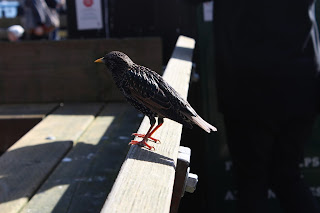Design #1 - Radioactive Flower
Theme: Warning sign - Advocacy - Environmental
Message
This sign shows strong irony. Radioactivity, in our case, is an
artificial occurrence, but I fashioned its warning sign out of a three-petaled
flower, a symbol of beauty in nature.
Method
I scanned my drawing and used the pen tool to trace it.
The eye
dropper tool matched the yellow exactly to a street sign.
Direct selection
enabled me to edit the petal shapes after deselecting.
Black and yellow were
chosen because they are the original sign colours, and also because there are yellow flowers.
~
Design #2 - Biohazardous Clover
Theme: Warning sign - Advocacy - Environmental
Message
This is a set with the Radioactive Flower sign. I created the
biohazard symbol with a 3-leaf clover.
It is ironic that biohazards, a result
of humans tampering with what is natural, are associated with an pure, natural
plant.
Additionally, by hiding nature within the unnatural, these signs hint that though the damage is severe,
nature is always quietly there, and that it isn't too late for redemption.
These two signs are intended to evoke a reflective reaction and break through the viewer's everyday approach to life.
Method
This sign was the most difficult to sketch and to trace, but it turned out well.
The direct selection tool enabled me to smooth the shape.
I tried different methods to have the three sticks surrounding the circle in the center (negative space), but what worked was simply making three black rectangles with the rectangle tool.
Green was used to emphasize the natural colour of the clover.
~
Design #3 - No Entry Into Universe
Theme: Limit Sign
Message
It is ironic that
entrance into the Universe is denied, as the Universe is everything. It is meant to make
the viewer wonder if humanity deserves the planet it was
given, if it is capable of such a responsibility, if it is worthy.
The sign is for everyone to see; everyone is part of this
world - and no one is exempt from the responsibility it comes with.
Method
I used a golden yellow instead of the standard red, so the sign
is the Sun, and all the planets are contained in it.
I wanted to draw my own planets, so I sketched, scanned them, and traced
them with the pen tool and the ellipse tool.
~
Design #4 - Harry the Bicyclist
Theme: Pop Culture
Message
At first glance, this sign only seems a little different.
But once you look deeper, familiar elements of a certain famous wizard surface.
This sign
uses wit to demonstrate that magic can be found in the most ordinary places, if
you look hard enough.
Life is what you make it out to be -
Every day can be magic.
Method
For the glasses and lightning bolt, I used a heavier weight so that they would stand out, but not so much so that it would appear crude.
Final Thoughts
My favourite was the first sign, the radioactive flower; the idea was a sudden stroke of inspiration, and it turned out even better than I envisioned it.
I had difficulties using Illustrator and knowing which tools to use to solve problems.
Lastly, I am satisfied with how my creations are original; I drew every sign instead of tracing images from Google. And rather than copying random signs by other people from of lack of inspiration, I made the project about things I have ideas about and care about.
Thanks for reading!




















































